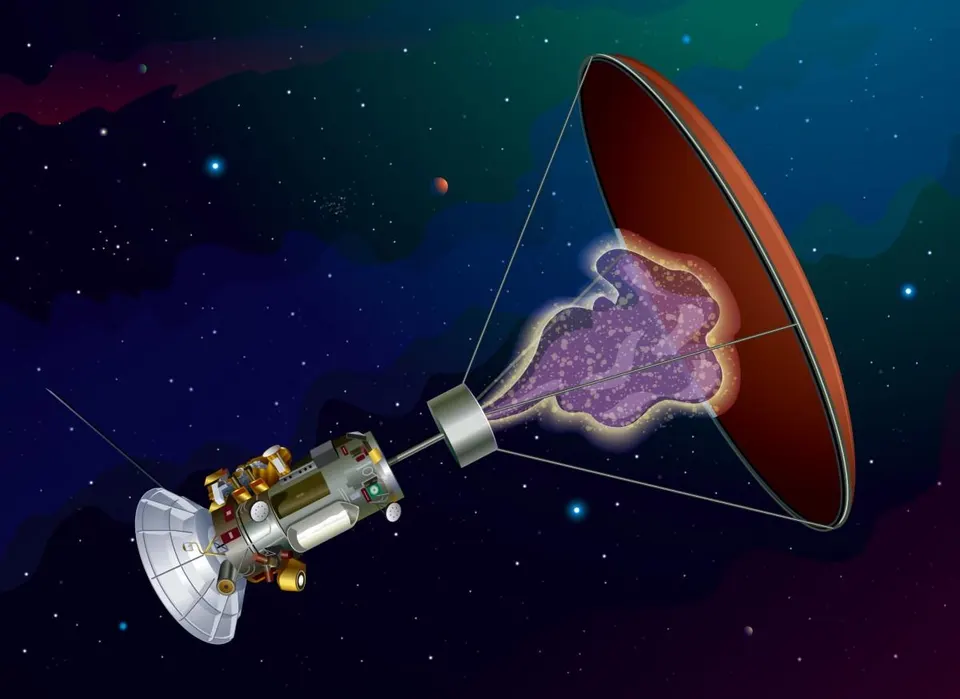Plasma pulses and aircraft survivability
Ions engine as cosmic heat air balloon
When we talk about things like plasma-ion engines, we forget that plasma-ion engines are ion cannons. The ion cloud's density is what determines if the engine is an ion- or plasma-ion engine. Low-density ion flow is an ion engine. High-density ion flow is a plasma-ion engine. The principle of those systems is that the ions will shoot through the particle accelerator.
And the problem is weak thrust in electrostatic thrusters. The weak thrust is the reason for the weak push against the front wall of the engine chamber. The answer to that thing would be the system that shoots ions into the middle of the engine from the sides, or the ion cannon, which can shoot ions at very dense metal plates. In that system, the ion engine pushes against the metal sail. The system functions similarly to a heat-air balloon, with the ion system operating in the opposite direction as usual. The idea for that system is taken from a Donald Duck strip where Donald sits in a boat and pushes air to sail by using a fan.
Originally, this image portrayed an antimatter engine. But it can also portray the ion engine that shoots ions at very dense metal plates. The idea is that the system uses thrust asymmetry. The pushing effect of that system is stronger from the front of the craft. And that thing makes it possible to move that craft through space.
We've all heard about plasma weapons.
Some plasma weapons are systems that cover an area with a plasma layer. The idea is that the plasma layer will prevent radiowaves from traveling through it. But laser systems can make information travel through those plasma layers.
If the aircraft can form a plasma pulse behind it, that system can make it possible to create new types of plasmoid and ion weapons. Researchers made tests where plasma pulses replaced the normal jamming torches of the aircrew. Those ion clouds or ion pulses can destroy an incoming missile's electronics. In some models, fast-flying drones or aircraft form an ion layer between the aircraft and a ground-based radar system. The idea is that the ion cloud will just block the radar from seeing through it.
There are models where GPS is jammed by using plasma layers. The problem is that the plasma layer denies all other radar-based communication through it. In some SDI (Space Defense Initiative) plans, the radar system creates a plasma layer between incoming missiles and denies radar echoes from ground areas.
The ion curtain between target and incoming missiles denies the ability to use radars, and that's why there are research programs for Lidar "laser radars" and optical area data communication.
The reason why radio is such a popular communication tool is simple. Radio waves travel through the walls. In some models, the hollow laser ray will cover the radio waves. The plasma will not disturb laser systems as much as it disturbs radio communication. In that model, either a laser or radio signal transports information to the goal.
But the problem with laser communication is that it will not pass the wall. The information travels in multi-layer radio-maser rays. The X- and gamma-ray lasers are tools that allow communication through walls. Also, terahertz-radiation-based communication could be the next-generation tool.
But there is a possibility that those plasma clouds will impact incoming missiles and aircraft. In that system, the target is loaded with the opposite polarity. That thing pulls that plasma to the target.
Normally, ion cannons are not dangerous because they use monopolar ions. But if there is an anion beam in the middle of the ion flow, that thing keeps those ions in one form. And that thing makes ion cannons able to operate at long range. Ion beams are the ultimate tools. Ions cannot travel through the wall without harming it. But when ions stop, they release their energy as the photon pulse.
That thing makes it possible to use ions as a light baton. Ion beams can also travel through walls, and if there is some target, the system can stop ions at the precise right point. And that makes ions transport their energy to that target. Stopping can happen by using a crossing ion beam or a very accurate magnetic beam. In that version, the ion cannon is equipped with an opposite-polar magnetic system that pulls ions or anions backward.
https://technologyandfuture4.wordpress.com/2023/08/26/plasma-pulses-and-aircraft-survivability/




No comments:
Post a Comment
Note: Only a member of this blog may post a comment.